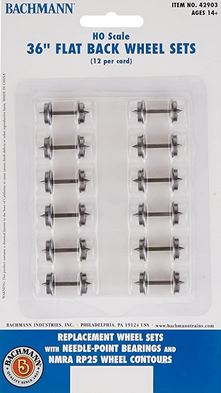Everything on model trains, model railroads, model railways, locomotives, model train layouts, scenery, wiring, DCC and more. Enjoy the world's best hobby... model railroading!
Swapping Plastic Wheels For Metal Wheels
“I have a lot of HO cars (different makes) with plastic wheels and over winter want to gradually swap them for metal which I think will run better. What size should I get? I see there are 33inch and 36inch. Does the make matter?”
To view the answers or add your own suggestion, leave a comment below.
















You should replace the wheels with the same size as the car came with. If you don’t you will have to adjust the couplers.
Prototype for HO is 33 for all cars except hoppers. For some reason many of them have 36”
But you would be fine with 33 on all of them.
Don’t skimp. Also can really improve performance if you ream out the trucks with the reamer tool from MidMark. It is an amazing tool,
Size does matter. Modern hoppers, tank cars, box cars and some reefers have 36″. Passenger cars usually have 36″. Auto racks have 28 or 33″. Intermodals have 33, 36, and 38″ wheels Most freight cars built before mid 70’s generally have 33″
You may have to go plastic wheels on metal axles on some cars that have metal on the bottoms where metal wheels may cause a short. Believe me when you’re trying to find the short and you take off all the engines and it’s still shorting out you take all your cars off it will be the last one if your luck is like mine.
me nice to know it happens to others
First order of business should be to get Micro-Mark truck tuning tool, works well and nice to have, regardless. You will likely find that not all trucks take the same length axe, etc & etc. This is where a very good wright up on truck tuning by Model Railroad Hobbyists Joe Fugate comes in. Great info in there, well worth perusing. Good luck.
Check the size of the wheels on your prototype and swap like for like,
I faced the same agenda when I got started again several months ago ( after 321/2 years ). Read how metal wheels was the way to go. Basically, 33″ wheels for Freight rolling stock and 36″ for passenger cars. Then have a height gauge and check and adjust as necessary. However, I will forewarn you, I you are running a DC system, if the trucks are metal, use those plastic wheelsets.
Using metal wheelsets with metal trucks DOES NOT WORK!!! causes shorts!!!
Why change? DCC- metal wheels tend to cause shorts in switches. Passenger cars can benefit from metal wheels if you want to light them. Most layouts are small and trains short. Drag is not significant in those trains to be affected by metal vs. plastic wheels.
Arthur,
Phil Johnson is providing good guidance as to what wheel size is prototypical. If you follow his advise yo may end up having to raise cars (insert washers between the bolster and the truck) or change couplers to drop the head for proper alignment with a coupler height gauge. From 3 feet away can you tell the difference between a 36″ or 33″ wheel?
Upgrading to metal wheels is definitely worthwhile. Your track stays cleaner, there is less rolling resistance (if done right) and they can help add weight to the car. To do this correctly you have to find trucks and wheel sets that are a good fit. This means that there should be minimal side to side movement of the wheel set within the truck. I use Tichy trucks and Intermountain wheel sets. There are numerous other combinations that work just as well. The point is that not all wheel sets and trucks are the same dimension. If the wheel sets are too long they won’t roll freely and if they are too short the wheels will tend to turn (not remain parallel to the track) when you don’t want them to.
At the same time the wheels have to be free rolling, This can be helped with the Micro Mark tuner mentioned above. I look for 10 seconds of free rolling when I flick the wheel set prior to mounting the truck to the car.
If you pay attention to all the points mentioned here you should have a more free rolling train and the option of pulling more cars with a given loco..
Very helpful. Thank you everyone.
Some great advice, thanks
Typically freight are 33″ wheels and passenger are 36″. That said, some more modern cars had 36″. Check prototype for that detail.